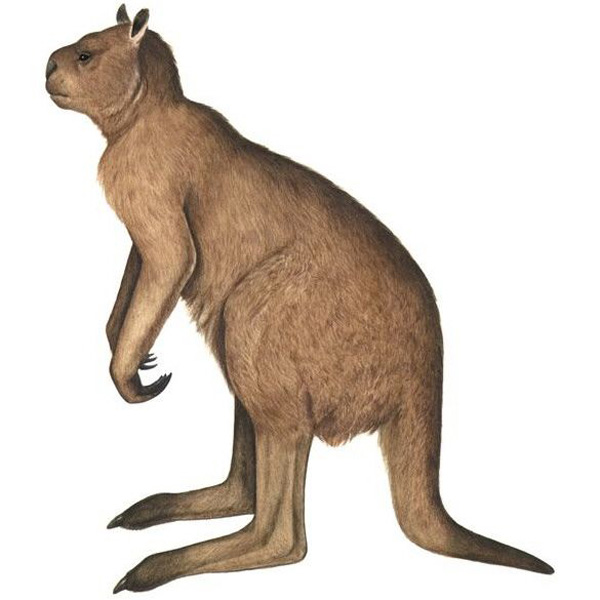Hey there every peoples!
Welcome to the second (sorta) week of Australia month. Whenever the extinct animals of Australia are mentioned, it’s the Pleistocene fauna. And even among that, only a select few are brought up. One of them is an animal who towered over everything else. It was a creature we are quite familiar with but was at the same time unlike anything living in Australia today. In a pitiful attempt to give it a common name, I call it: the megaroo.
The scientific name is Procoptodon goliah. Like many other Australian megafauna it was named by Sir Richard Owen in 1873. And like Palorchestes, he ascribed the initial fossils to a giant kangaroo (except he was actually right about this animal). Procoptodon was a member of a subfamily of kangaroos called sthenurines. Sthenurines trace their origins back to the late Miocene, possibly with the kangaroo Hadronomas. Sthenurines were characterized by a short skull and a very robust skeletal structure. Many species of Procoptodon are known, all from the late Pleistocene. Procoptodon goliah gets all the press because he was the largest and most spectacular of this lineage.

Reconstruction of Procoptodon goliah. From the book “Prehistoric Mammals of Australia and New Guinea: 100 million Years of Evolution”
Following the trend of Pleistocene gigantism, Procoptodon was big. Fully grown, it was have stood 7 to 7 1/2 feet tall and weigh in excess of 400 pounds. Now this may not sound that big compared to the megafauna elsewhere in the world, but it’s pretty big for Australia. Especially when you consider that it is much taller and over twice as heavy as the largest modern kangaroo, the red kangaroo.

Comparison of the thigh bones of a red kangaroo and Procoptodon (from the Discovery Channel documentary “Monsters Resurrected:Giant Ripper”)
As a sthenurine, Procoptodon was a browser. Because they fed on higher vegetation (most modern kangaroos and wallabies are grazers) they could do something most other kangaroos can’t: they can reach above their head. Combined with the length of its arms and huge hooked claws, Procoptodon could reach leaves 9 feet off the ground. Now in the last post I mentioned how Palorchestes is often labeled as Australia’s version of a ground sloth. However, I feel Procoptodon is the better proxy. Most ground sloths made their living as browsers, filling the niche occupied elsewhere by giraffes and elephants. Ground sloths are thought to have uses their claws to pull down branches. Sounds an awful lot like Procoptodon, doesn’t it?

“Hey Macropus rufus. Why don’t you come and join me and… Oh right, you can’t! You don’t have the skeletal articulation. Nana *thhppppttt*!” (reconstruction published in National Geographic Magazine)
Procoptodon wasn’t just unusual in its size and short face. The sthenurines of the Pleistocene were unique in having only a single toe on each foot. Modern kanagroos and wallabies have 4 toes. In Procoptodon, this single tow ended in an enormous claw. Modern kangaroos are well known for their kick boxing style of fighting, which while used manly against other kangaroos also serves a defense against predators. A modern kangaroo can knock a full grown human on their ass with ease. With a lot more muscle and that huge claw, Procoptodon probably had a kick to make any martial artist jealous. Given the predators stalking the Australian bush during the Pleistocene, size alone may not have been enough to protect Procoptodon. A good kick from this beast could probably send even the most brazen hunters packing.

A pair of red kangaroos kick boxing. Now imagine the same thing with animals the size of a small grizzly bear!
Like the other megafauna in Australia, Procoptodon died out around 50,000 years ago. Many experts think the first humans in Australia lived with and hunted these animals. Rock art resembling some meagafauna hints at this possibility. There is an aboriginal legend of a large fighting kangaroo, which may have been inspired by encounters with Procoptodon. How those encounters may have played out is anyone’s guess. In any case, i am rather envious of them. At least they got to see this magnificent animal in the flesh.
Till next time!

